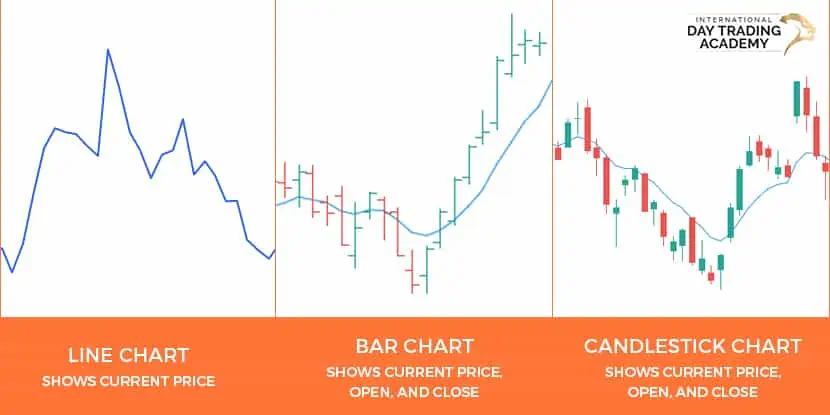Day Trading is the practice of buying and selling Shares, Futures, Forex, Commodities, Crypto or Options within the same session in order to generate profits. It involves making fast and calculated decisions that take advantage of market volatility.
Day Trading in Australia can be executed through a broker, or directly through an exchange, such as the ASX, or S&P500 using products like Futures. Australia has a strong and vibrant financial market with thousands of publicly traded companies listed on the ASX. With access to local and international assets, Day Trading in Australia is rife with opportunity.
Before you begin trading, it is fundamental that you first understand the basics of how to Day Trade in Australia. This will ensure that you enter the market with the right tools, strategies and knowledge to mitigate risks and seek to generate profit.
How to Day Trade in Australia; Day Trading Rules Australia
Day Trading in Australia is relatively similar to Day Trading in other international markets. As is the case with all markets, the most important step in learning how to Day Trade in Australia is to understand the terminology and logistics behind it. This allows you to develop a Day Trading strategy that works best for you.
Of course, understanding the fundamentals of market design, trading charts, and market indications is the first step you should take in order to learn how to Day Trade in Australia. Successful Day Trading relies on conducting accurate analysis on historical and live data.
Technical analysis of trading chart patterns is what allows a trader to identify potentially profitable trades.
Types of trading charts include:
- Line charts:
The simplest form of chart, which only displays the closing price at a certain period of time. - Bar charts:
Offering more information than a standard line chart, bar charts illustrate the highest and lowest price points reached during a specific period. They also show open price and close price - Candlestick charts:
The most popular chart amongst traders and particularly useful for beginners. They are simple to read and offer several key insights including the open price and close price.

Understanding how insights can be pulled from a trading chart is extremely important for all Day Traders. Before a beginner actually starts Day Trading in Australia, they should first learn to accurately read trading charts.
Being able to effectively utilise trading charts will allow you to determine the following features of the market:
How to Day Trade in Australia
Markets for Day Trading in Australia
In Australia, there are various markets open for Day Trading. These include Stocks, Futures, Forex, Cryptocurrency, Options, and Binary Options. Before deciding what market you are intending to trade in, it’s important that you understand its design and its associated advantages and disadvantages.
We prefer to teach Futures trading above other forms of trading for a number of different reasons. The Futures market offers fair and transparent pricing without the need for a traditional Over-the-counter broker, while also allowing for traders to leverage a smaller amount.
With high liquidity and over 70 different Futures markets available, Futures are particularly appealing for many beginner Day Traders in Australia.
Our Live Trading Room sessions are also useful for beginners looking to engage with real-time markets, with different options available for all traders no matter their level of expertise.
Here are some market comparisons:
Futures vs Forex
Futures vs Stocks
Futures vs Options
Futures vs CFDs
Trading Session Times for Day Trading in Australia
One of the most beneficial aspects of Day Trading in Australia is having flexibility when it comes to trading times. With many different sessions available for Day Trading, beginner Day Traders can organise their trading around a time that suits their specific lifestyle.
Trading hours with the ASX are Monday to Friday, 10am to 4pm AEST. Pre-open trading hours take place between 7am to 10am. During this time, traders can place orders that are then fulfilled according to price-time priority once the markets open. However, pre-markets are considerably less popular world-wide due to low volume, which means predictability is also low.
Most Day Traders will trade at either the open or close of their selected market, as it is during these times when the market has the most volume and offers more opportunities.
Before You Start Day Trading in Australia
Before you start Day Trading in Australia, you should identify which session you are looking to trade in. Choosing to trade in the European, American or Australian markets, as well as the products you choose to trade, will impact the hours you will need to set aside for your Day Trading.
Learn to Trade in Australia
It is a lengthy process to learn to trade in Australia – and a process in which you can’t afford to cut corners. This is especially true if you’re considering advanced day trading techniques or strategies.
After learning how day trading (and scalping trading) markets work, and deciding what assets you are planning to trade in, the next step in understanding how to trade in Australia is to open a demo account.
Demo accounts provide an accurate and realistic environment for beginners to grasp the basics of Day Trading in Australia., This is achieved without risking real money. Apart from using virtual money, demo accounts essentially function in the exact same way as real accounts. This simulated environment allows beginners to develop their trading strategies before entering the real market.
We recommend beginners use the industry-leading market simulator NinjaTrader to practice their trading strategies. NinjaTrader offers users free access to simulated Futures markets while also providing users with advanced market analysis and professional charting.
When you decide on a strategy to use when Day Trading in Australia, it’s important that you remember to stick with it. Each strategy comes with strict rules that must be followed when executing a trade, and straying too far from your strategy can result in losses. It’s better to master one strategy rather than being sufficient at a number of different ones.
Day Trading Strategies
Day trading is a powerful approach to the stock market that requires traders to buy and sell within the same trading day. Successful day trading relies on a combination of strategies tailored to your individual preferences, unique needs, risk tolerance, and market conditions.
Here are some popular day trading strategies that are commonly used in Australia:
- Scalping: This strategy involves making small, quick trades to profit from minimal price fluctuations. Scalpers aim to capitalise on market inefficiencies and often execute dozens of trades in a single day.
- Momentum Trading: Day traders using momentum trading strategies focus on stocks or assets with strong upward or downward trends. They aim to ride the momentum and exit before it reverses.
- Range Trading: Range traders identify stocks that are trading within a defined price range and attempt to profit from price oscillations within that range. They buy low and sell high or short sell high and cover low.
- Trend Following: This strategy involves identifying and following established trends, whether they are on the uptrend or the downtrend. Trend-following traders use technical analysis tools to confirm trends.
- Breakout Trading: Traders using breakout strategies look for stocks that are on the verge of breaking out of a trading range or pattern. They anticipate significant price movements when these breakouts occur.
It’s crucial to note that while these strategies offer opportunities for profit, they also come with risks that all day traders must manage effectively to help minimise their potential losses.
Are There Possible Risks of Day Trading?
Day trading can be highly profitable, but, like anything, it’s also not without its risks.
Here are some potential risks you should keep in mind that are associated with day trading in Australia:
- Financial Losses: Day trading involves quick decision-making, and even small mistakes can lead to significant financial losses. High leverage can amplify losses. This is why we focus on trading risk management as a pillar of our education, and trading strategies.
- Stress: The fast-paced nature of day trading can lead to emotional stress, anxiety, and burnout, especially during volatile market conditions.
- Lack of Diversification: Day traders often focus on a few stocks or assets, which can result in a lack of diversification in their portfolios, increasing risk. This is especially true for traders that do not have access to short trading. It is less of an issue with derivatives such as Futures as the market can be traded up and down.
- Regulatory Risks: Day trading is subject to regulations and may require substantial capital, depending on the broker and market. Violating rules can lead to penalties.
- Overtrading: Overtrading, or excessive trading, can erode profits through commissions and increase the risk of making impulsive decisions.
- Market Volatility: The Australian stock market, ASX, for example, can experience significant volatility. Day traders may encounter unexpected price swings.
To help ease these risks, aspiring day traders should educate themselves thoroughly – our team at IDTA can help educate you on all the risks and how to do your best to avoid them.
Practising When Day Trading in Australia
Before you finally start day trading with real money, it’s important that you set aside a specific amount of time and funds. You should assess in thorough detail how much money you are willing to risk before you begin Day Trading.
Most traders risk less than 1% or 2% of their accounts with each trade. Set aside a firm amount of money you are willing to risk, and remember to stick by it.
Another important detail of Day Trading in Australia is keeping up to date with market trends and news. Record the markets you are interested in trading in, along with any research you have conducted about them in a Day Trading journal. A Day Trading journal can also be used to track your performance and risk management. Documenting both market trends and your trading decisions can help serve as a means of measuring progress.
Ultimately, finding the right resources is an integral first step in learning to trade in Australia. We offer a range of Day Trading courses in Australia designed specifically for beginners. Explore our range of online trading courses taught by professional Traders and Educators.
Is Day Trading Legal in Australia?
Day Trading in Australia is completely legal; However, it’s important you trade with a regulated and trusted provider.
Unregulated brokers are not required to follow any rules, meaning they can take advantage of investors or engage in other unethical business practices that could result in you losing money.
Is Swing Trading the Same as Day Trading?
If you’re interested in a less intense approach to trading compared to day trading, swing trading may be the type of trading for you! Swing trading involves holding positions for several days to weeks, capitalising on price swings within the broader trends of stocks or assets.
To learn more about swing trading, visit our comprehensive guide on Swing Trading Strategies.
Swing trading offers a more relaxed trading pace, making it a great alternative for traders seeking a less focus driven form of trading, while still aiming to make a profit.
Day Trading Courses in Australia
Day Trading in Australia requires continual learning and improvement, no matter whether you’re a beginner or an expert.
If you are looking for resources to help you learn to trade, you can explore our range of online stock trading courses in Australia that are taught by industry experts. Our Trading Course Bundle teaches beginners a step-by-step guide on how to Day Trade in Australia and world-wide.



![Trading Futures in Australia [How to Get Started]](https://idta.com.au/wp-content/uploads/2022/03/trading-futures-in-australia-how-to-get-strated-500x383.jpg)
![How To Be a Lifestyle Trader [What to Know]](https://idta.com.au/wp-content/uploads/2022/03/lifestyle-trader-day-trading-while-travelling-using-laptop-500x383.jpg)